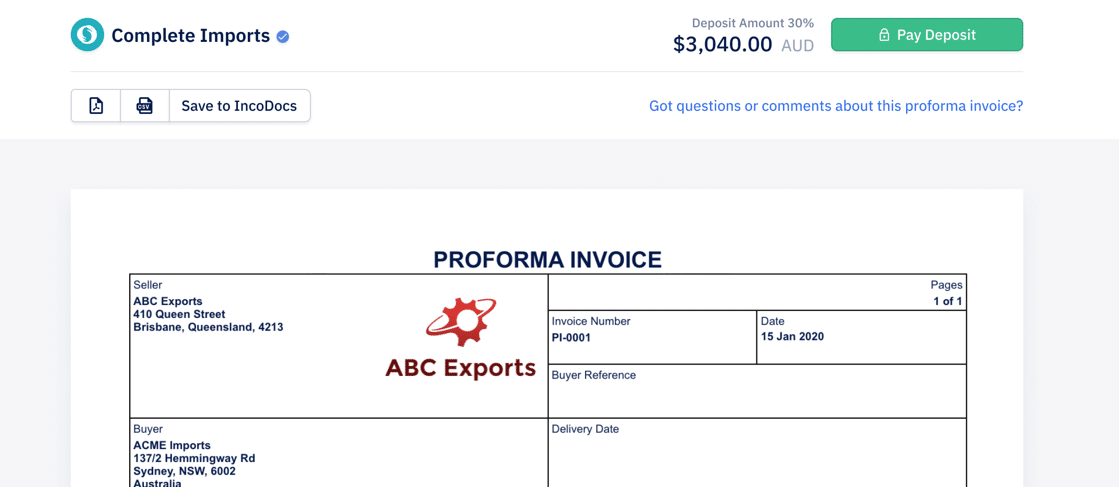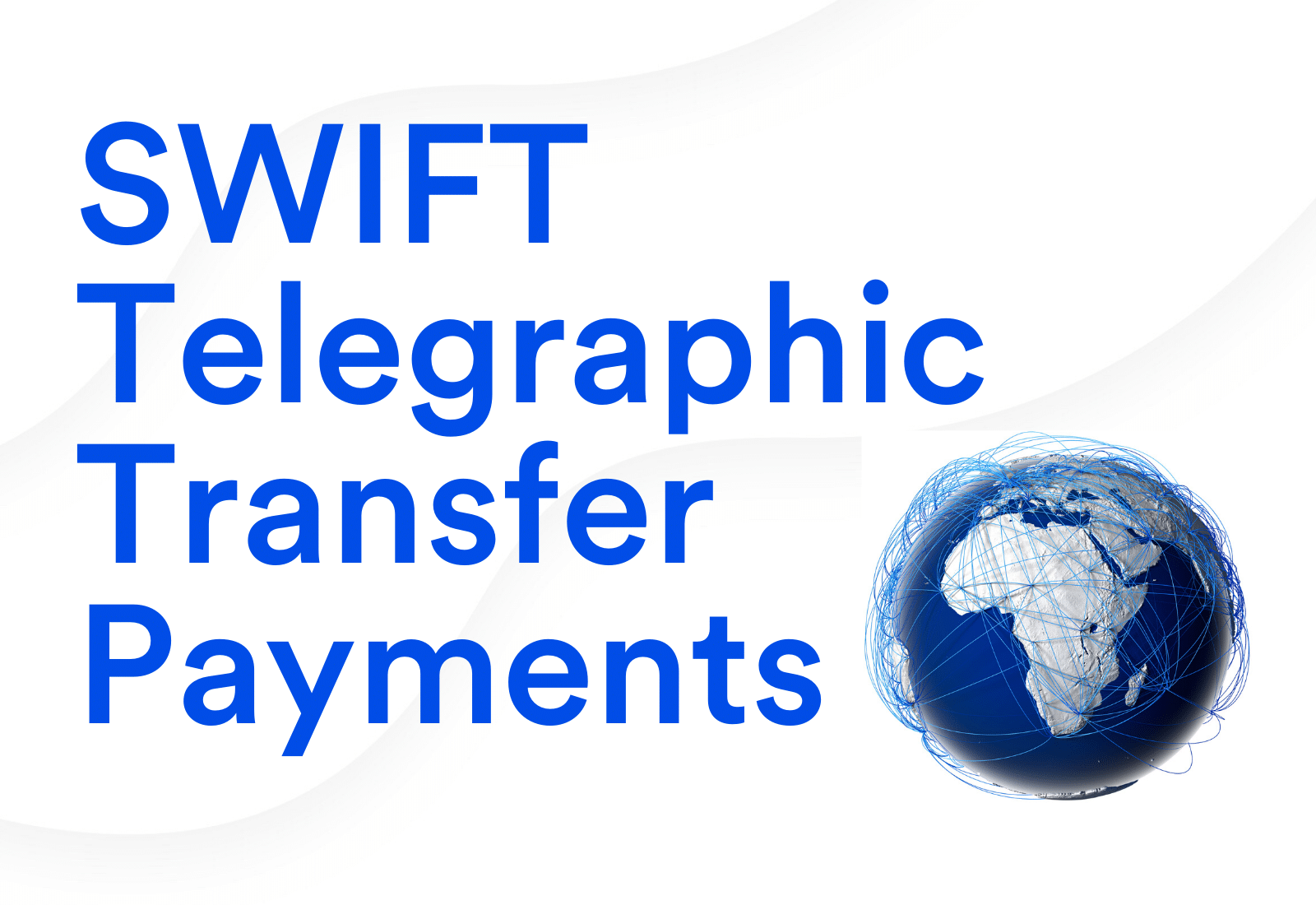If you’re involved in Global Trade you would be aware that importers and exporters agree to sell goods on agreed payment terms that usually involve a SWIFT Telegraphic Transfer, or T/T payment. Before products can be exported around the world the buyer and seller will agree on the terms of trade (including Incoterms®) then include all details in Purchase Orders, Proforma Invoices and Sales Contracts that are countersigned by both parties.
When the terms in the contracts are agreed, the buyer will need to make an International payment to the overseas supplier.Buyers most often transfer funds internationally by Telegraphic Transfer (T/T) to send money to overseas suppliers. However, there are different payment methods that buyers can use to transfer money Internationally. International money transfers usually require exchanging currencies and come with costs and fees.
It’s important for importers to understand their payment options and how to secure the best exchange rate for International payments to overseas suppliers. Here’s a list of some types of International payment methods buyers can use to send money overseas:
International Wire Transfers via Banks – SWIFT Telegraphic Transfer TT payments
Buyers can make International payments through their local banks. Most banks will use the SWIFT banking system. You can walk into a bank to make an International wire transfer, but unless you have negotiated a good foreign exchange rate with your local business banker, this option will generally not provide a good exchange rate. Some banks will offer an online version of their SWIFT payment system for buyers to login and make payments online. Read more details on how International wire transfers work further down.
Foreign Exchange Providers with Good Exchange Rates
Foreign Exchange (FX) Providers are companies that can offer very competitive foreign exchange rates for importers to make SWIFT payments Internationally. They operate independently to banks and can negotiate good deals for International wire transfers.
Credit Cards for International payments
Credit Cards are easily accessible for buyers in most countries around the world. Payment by VISA, Mastercard or American Express credit cards can be an easy but quite expensive option to make International payments, especially for high value transactions.
PayPal for International Payments
PayPal is a popular alternative payment method that allows users to transfer funds internationally, offered by many vendors around the world. However, making an International foreign exchange payment using PayPal will not give a good exchange rate to the payer. It is not ideal for high value transactions and is generally used for convenience.
Western Union Wire Transfer
Western Union is a transfer service that has been operating since the 19th Century. Some suppliers may still request payment via Western Union but making International payments this way have proven to take a long time to clear into the seller’s bank account. Western Union generally do not offer buyers good exchange rates and have high fees and charges.

An overview on International payments using SWIFT, Wire or Telegraphic Transfer (T/T)
SWIFT is a system that is behind most of the world’s International money and security transfers. Banks and financial institutions use it to securely transmit information and instructions through a standardized system of codes (made up of 8 or 11 characters). Before the SWIFT payment system, Telex was the only means to make International funds transfer which required senders to describe transactions in sentences which were interpreted and executed by the receiver. The Telex process was a slow, unsecure process that was prone to human errors.
The SWIFT (Society for Worldwide Interbank Financial Telecommunications) system, formed in 1974 by 7 major international banks, is widely used to facilitate secure international money transfers using the SWIFT network. It began a cooperative society to operate a global network to transfer financial messages faster and more securely than the Telex system. Today the SWIFT network is the global standard for transferring money Internationally.
The Differences Between Telegraphic Transfers and SWIFT Payments
In international business, you’ll hear terms like “Telegraphic Transfer”, “SWIFT wire transfer”, “tt payment”, and “telex transfer”. These aren’t just fancy words; they’re important parts of how money moves around the world. Simply put, A Telegraphic Transfer (T/T) is a method of transferring funds from one bank account to another electronically. SWIFT wire transfers are a special system banks use worldwide to safely share details, including how to move money. It’s important for everyone in business to know what these terms mean to make sure money transfers go smoothly and safely.
How long does a SWIFT payment take to clear into the receiver’s bank account?
The SWIFT network relies on transferring funds from one account to another between multiple banks before the funds are received in the seller’s bank account. This process can take anywhere from 1-5 working days, depending on the banks’ processing times and the countries involved in sending and receiving the transaction. Public holidays will add to the time taken to clear money into the beneficiary’s account.
What details must the exporter provide to the importer to make an International SWIFT wire transfer?
Exporters will generally share a Proforma Invoice or Commercial Invoice that includes all details of the order, along with their SWIFT and IBAN bank account information, requesting the buyer to make a bank transfer via Telegraphic Transfer (T/T). The exporter may request a deposit payment to get the order under production. The bank details will include the below:
Beneficiary Details
- Beneficiary Business Name
- Beneficiary Business Address
Payee Bank Details
- SWIFT Code (Bank ID). Each financial institution in the SWIFT network has a unique SWIFT code that is between 8 and 11 characters. This is known as a SWIFT ID or a bank identifier code (BIC). You can lookup a SWIFT/BIC Code here. For example, to make a Bank of America wire transfer, the Bank of America SWIFT code is BOFAUS3N
- Bank Location (Country)
- Bank Location (City)
- Bank Name
- Intermediary Bank Details (optional). If the seller uses an Intermediary bank to accept payments, the Intermediary bank details should also be included, i.e. SWIFT Code (Bank ID) Bank Location (Country), Bank Location (City), Bank Name.
- IBAN – International Bank Account Number
Transaction Details
- Transaction Currency
- Transaction Amount
- Reference Number (generally a unique Invoice or Purchase Order Number)
How to make International Wire Payments via SWIFT network
If you are logging into a Bank or foreign exchange provider’s online system, you can login to make the International Wire transfer as below:
- Login online (usually using Two-Factor Authentication – 2FA)
- Add a new Payee (if making a payment to them for the first time).
- Enter the buy or sell currency amounts and the system should display the foreign exchange rate offered to you to make the payment. You will have a limited amount of time to accept the foreign exchange rate offered. Read more on securing the best foreign exchange rate below.
- Click to confirm the rate then assign the payment to a Payee.
- You should be able to add any additional information related to the payment, such as date, reference number, Payment Reason and SWIFT fee charge type (OUR, BEN or SHA). Read more on OUR, BEN and SHA payment fees further down.
- Review all of the information entered.
- Submit to confirm the payment.
How to secure the best foreign exchange rate for International Wire transfers.
Over the last decade growing competition in the foreign exchange space has provided consumers with access to better foreign exchange rates to send money overseas. In the past the banks have dominated the market, but today there are quite a few options to make better International wire transfers with great exchange rates.
Before you send money overseas, you should take the time to research and accurately understand the foreign exchange rates and processing times offered by each option, as these can differ significantly from domestic transfers. A small difference over high value transactions can mean tens of thousands of dollars saved.
Check with your bank, foreign exchange providers and other providers such as PayPal and Western Union mentioned above. Call your bank and other foreign exchange providers to find out the exchange rates they can offer. Ask if they have a minimum transaction amount? Does the foreign exchange rate that they offer fluctuate with different volumes? How long can they secure your rate? Do they provide a web login where you can check rate and make payments easily? Some foreign exchange systems are quite old, so the experience of logging in to make a payment can be terrible.
Exchange rates are changing every minute. A simple way you can check the latest rates is to use Google’s currency converter. Type “currency converter” into Google’s search or Google Chrome and you can select currency types and amounts to check the conversion rates. This is known as the ‘mid-market’ exchange rate or ‘interbank’ exchange rate. When you compare the foreign exchange rate that you can secure with a bank or FX provider, you can compare it back to this rate.
Don’t just compare the foreign exchange rate, also compare the transaction fees.
What are the fees involved with processing International SWIFT T/T payments?
When you are comparing your foreign exchange rate providers make sure you also understand the fees that are charged per transaction. Some banks can charge $40 or more, and it’s also important to understand that the receiving banks may also charge fees. There can be anywhere from 1-3 intermediary banks that charge fees.
Therefore, make sure you do your research to understand these additional costs as there are some foreign exchange providers that have more competitive fees compared to the banks.
What are OUR, SHA and BEN payment fee types for International SWIFT payments?
When you make an international wire transfer you can choose which party will pay the fees for the International transfer. BEN, SHA and OUR are codes that payers can select when making a SWIFT payment to confirm which party or parties will cover the transaction fees.
OUR instruction:
Selecting OUR will confirm that the Payer (sender) will be charged all of the International payment fees. The beneficiary (receiver) will receive the full amount of the payment without any fees deducted from the payment.
SHA instruction: SHAred
Selecting SHA will share the fees between both the Payer and Payee. The Payer (sender) will be charged the fees of the sending bank, the Payee (receiver) will be charged the fees of the corresponding receiving bank.
BEN instruction: BENeficiary
Selecting BEN will pass all of the payment transaction fees onto the Payee (the recipient of the payment). The recipient will receive the payment minus the transfer fees and charges. The Payer (sender) will not be charged any of the payment fees.
How Exporters and Importers use IncoDocs to create Proforma Invoices and Commercial Invoices to close more deals and get paid fast.
- Buyers and Sellers create a free account
- Sellers use International trade templates to easily create Proforma Invoices and Commercial Invoices to share with buyers
- Buyers click to comment, accept and countersign invoice and purchase order contracts online
- Buyers have click to pay options to make International T/T wire transfers in a few clicks
How Telegraphic Transfers Affect Landed Cost
Payment types like Telegraphic transfers (TT) and SWIFT can significantly impact the landed cost of goods. Landed cost includes the product price, shipping, customs, duties, and insurance. When you use TT or SWIFT, you must consider the associated fees and exchange rates. These fees can add up quickly. For example, transferring $10,000 with a 2% fee adds $200 to your costs.
Calculating these costs accurately is important. Knowing the fees and exchange rates helps avoid unexpected expenses and ensures better budgeting for international trade. By knowing the exact costs involved, businesses can price their goods more competitively and avoid surprises. This accuracy is vital for maintaining profitability in global markets.

FAQ on Telegraphic Transfers (TT) and SWIFT
Is Telegraphic Transfer (TT) same as bank transfer?
No, telegraphic transfers aren’t the same as all bank transfers. A telegraphic transfer (TT) is a specific type of electronic funds transfer used primarily for international money transfers, typically involving the SWIFT network. Domestic transfers often use different systems and can be processed faster and with different fees.
Is SWIFT the same as telegraphic transfer?
SWIFT is the Society for Worldwide Interbank Financial Telecommunication, a network used for international banking communication. A telegraphic transfer (TT) is a method of transferring funds from one bank account to another, often using the SWIFT network for secure transactions. They are related but not the same.
Is a Telegraphic Transfer (TT) payment instant?
No, a TT payment is not instant. The transfer process typically takes 1 to 5 business days, depending on the banks and countries involved in the transfer. Factors like transfer details, intermediary banks, and processing times can affect the duration of TT transfers, making them slower than domestic transfers.
Why is the term “TT payment” commonly used in international trade?
The term “TT payment” is commonly used in international trade because it refers to telegraphic transfers, a secure and widely accepted method of transferring funds between countries. TT payments involve using the SWIFT network, ensuring reliable and efficient international money transfers, which are essential for global trade transactions.







